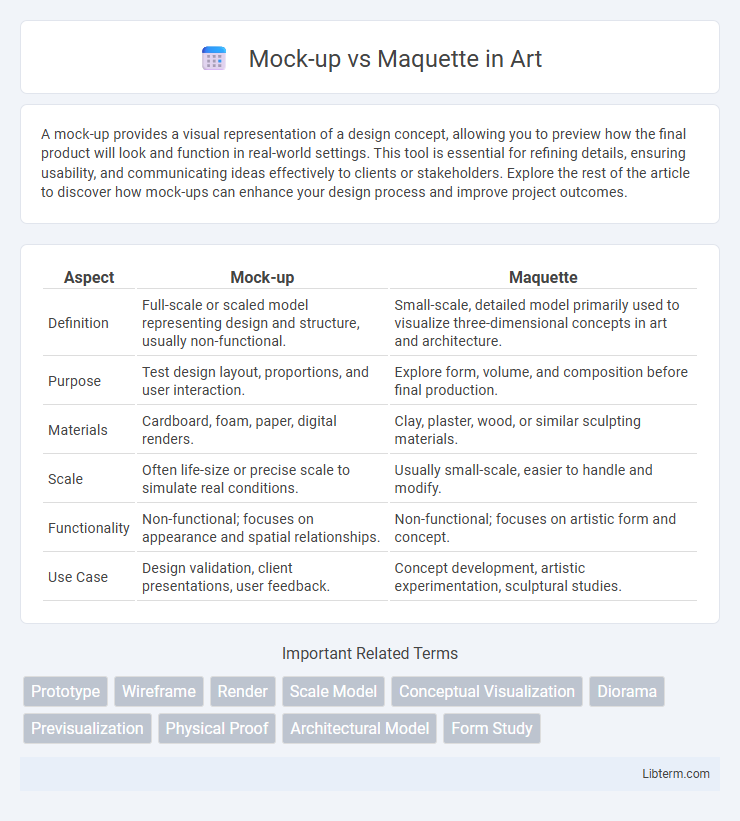A mock-up provides a visual representation of a design concept, allowing you to preview how the final product will look and function in real-world settings. This tool is essential for refining details, ensuring usability, and communicating ideas effectively to clients or stakeholders. Explore the rest of the article to discover how mock-ups can enhance your design process and improve project outcomes.
Table of Comparison
| Aspect | Mock-up | Maquette |
|---|---|---|
| Definition | Full-scale or scaled model representing design and structure, usually non-functional. | Small-scale, detailed model primarily used to visualize three-dimensional concepts in art and architecture. |
| Purpose | Test design layout, proportions, and user interaction. | Explore form, volume, and composition before final production. |
| Materials | Cardboard, foam, paper, digital renders. | Clay, plaster, wood, or similar sculpting materials. |
| Scale | Often life-size or precise scale to simulate real conditions. | Usually small-scale, easier to handle and modify. |
| Functionality | Non-functional; focuses on appearance and spatial relationships. | Non-functional; focuses on artistic form and concept. |
| Use Case | Design validation, client presentations, user feedback. | Concept development, artistic experimentation, sculptural studies. |
Introduction to Mock-ups and Maquettes
Mock-ups and maquettes serve as essential tools in design and architecture, offering tangible representations of concepts before final production. A mock-up is a full-scale or scaled model used to visualize and test design elements, materials, and functionality in realistic settings. Maquettes, typically smaller and more detailed, provide a three-dimensional sketch that helps refine proportions and spatial relationships during the early stages of creative development.
Definitions: What is a Mock-up?
A mock-up is a full-scale or scaled model of a design used to visualize and evaluate the appearance, layout, and functionality before final production. It serves as a tangible prototype that allows designers, clients, and stakeholders to assess design elements and ergonomics in a realistic context. Mock-ups are commonly used in industries like architecture, product design, and web development to detect potential issues and gather feedback early in the development process.
Definitions: What is a Maquette?
A maquette is a small-scale, three-dimensional model used in art and design to visualize and experiment with the form and structure of a sculpture or architectural project before full-scale production. Unlike a flat mock-up, a maquette provides a tangible, spatial representation that captures volume, texture, and proportions. These preliminary models help artists and designers refine their concepts and plan the final work with greater accuracy.
Key Differences Between Mock-ups and Maquettes
Mock-ups primarily serve as full-scale models used in design and architecture to visualize the final product's appearance and functionality, whereas maquettes are smaller-scale, detailed sculptures or models used mainly in art and sculpture to explore three-dimensional concepts. Mock-ups emphasize accuracy in dimensions and usability for practical feedback during the development process, while maquettes focus on artistic expression and form refinement before the creation of a final piece. Key differences include scale, purpose, and application: mock-ups aid in technical evaluation and client presentations, while maquettes assist in conceptual development and artistic experimentation.
Common Uses of Mock-ups in Design
Mock-ups in design serve as detailed visual representations that help designers and clients evaluate aesthetics, layout, and spatial relationships before final production. Common uses include testing user interfaces in web and app development, refining product packaging, and presenting architectural concepts to stakeholders. These prototypes allow for iterative feedback, saving time and resources by identifying issues early in the design process.
Common Applications of Maquettes in Art and Architecture
Maquettes serve as essential scale models in art and architecture, enabling detailed visualization and spatial planning before full-scale production. Artists use maquettes to experiment with composition, form, and texture, while architects create them to assess structural design and presentation. These tangible prototypes facilitate communication among designers, clients, and fabricators, ensuring precision in the final work.
Materials and Techniques for Creating Mock-ups
Mock-ups are typically constructed using inexpensive, flexible materials like foam board, cardboard, and clay to allow for easy modifications during the design process. Techniques for creating mock-ups often involve rapid prototyping methods such as cutting, scoring, and assembling these materials, enabling designers to quickly visualize and test concepts. In contrast, maquettes are usually made from more refined materials like plaster, wood, or resin, emphasizing detailed craftsmanship and permanence.
Materials and Techniques for Building Maquettes
Maquettes are typically constructed using lightweight materials such as clay, foam, cardboard, or wood to allow detailed sculpting and easy modifications, contrasting with mock-ups that often use cheaper materials like cardboard or plastic for simple visual representation. Techniques for building maquettes include hand-carving, molding, and assembling small components to create precise three-dimensional models that capture the final design's form and texture. These detailed materials and techniques make maquettes valuable for visualizing sculptures, architectural projects, and product designs before full-scale production.
Choosing Between a Mock-up and a Maquette
Choosing between a mock-up and a maquette depends on the project's purpose and stage. Mock-ups are typically full-scale, functional prototypes used for testing usability and design details, ideal for product development and interface design. Maquettes are smaller-scale, three-dimensional models mainly employed in architecture and sculpture to visualize spatial concepts and overall form before final production.
Conclusion: Selecting the Right Model for Your Project
Choosing between a mock-up and a maquette depends on the project's purpose: mock-ups offer full-scale, functional prototypes ideal for testing usability and design adjustments, while maquettes provide small-scale, detailed representations suited for visualizing concepts and spatial relationships. Consider factors such as project stage, budget, and desired feedback to determine the appropriate model. Integrating the right type enhances design accuracy, stakeholder communication, and overall project efficiency.
Mock-up Infographic

 libterm.com
libterm.com